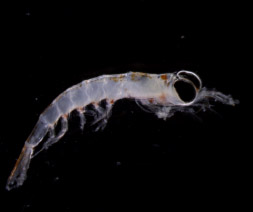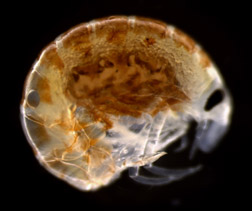Animals in Ocean’s Twilight Zone Thrive on Upcycled Nutrients
Living at the edge of darkness, the community of microbes and tiny animals in the ocean’s twilight zone upcycle nutrients to ensure their survival. A study led by researchers at the University of Hawai‘i at Mānoa revealed that small, free-floating animals called zooplankton rely mainly on an even smaller class of organisms, called microzooplankton, to consolidate the sparse waste products in the water and transform it into higher-quality food. The study was published in Limnology and Oceanography.
“Zooplankton have, at times, been termed ‘gatekeepers’ of the deep sea because their feeding behavior determines which materials reach the ocean’s deep interior,” said Connor Shea, lead author of the study and doctoral student in the UH Mānoa School of Ocean and Earth Science and Technology (SOEST) Department of Oceanography. “So, it is important to understand how these animals source their food because it helps us understand how the ocean processes and stores carbon dioxide from Earth’s atmosphere.”

Neocalanus spp.: Copepods of the genus Neocalanus dominate the zooplankton community in the Subarctic Northeast Pacific Ocean for much of the summer, before migrating to the deep sea to reproduce and eventually die. Photo credit: Karen Stamieszkin
The twilight zone, about 200–1,000 meters below the ocean surface, is the layer where the well-lit surface ocean transitions to the ocean's dark interior. In this zone, it is too dark for plants to grow, so the communities that live there are almost entirely reliant on material produced in the overlying water to survive.
To obtain their food, microzooplankton, which are about the size of a human red blood cell, recycle old organic material that settles from above—mostly fragments of excrement from animals living at shallower depths. This process concentrates nutrients in an environment that is otherwise a food desert for other, larger organisms.
Food web structure
Shea and his co-authors collaborated with a large, interdisciplinary team of scientists through the EXPORTS program to investigate the dynamics of the zooplankton community in the subarctic Northeast Pacific Ocean, in the Gulf of Alaska. The team collected samples of zooplankton and analyzed nitrogen isotopes within them. The analysis allowed the researchers to make inferences about how the food web is structured.
“We discovered how the community of zooplankton living in the twilight zone of the Northeast Pacific makes a living, despite inhabiting a notably unproductive region where the supply of food from the surface is exceedingly low,” said Shea.
The zooplankton, which are about the size of a sesame seed and often smaller, eat the microzooplankton, which are relatively nutritious compared to the detritus they feed on. In this way, the food web is highly efficient and organized around the recycling of relatively low-quality food that exists in this environment.

Thysanoessa inspinata: T. inspinata are one of the most abundant euphausiid (krill) species in the North Pacific Ocean. Photo credit: Karen Stamieszkin
“Although we know that microzooplankton exist below the well-lit surface ocean, they are not very abundant, and so it has previously been difficult to evaluate whether they are an active component of the community,” said Shea. “So, it was exciting to find that they were key contributors to this deep sea food web.”
Regions of the ocean where the plankton community is more efficiently utilizing organic matter, such as the study area, are places where the ocean has a naturally lower capacity to absorb some of the carbon dioxide produced by humans. “So understanding how zooplankton communities process carbon, which, to them, represents food and energy, helps us to understand the role of the ocean in absorbing carbon dioxide in the atmosphere,” added Shea.
Amy Maas, ASU BIOS biological oceanographer and NASA EXPORTS collaborator and co-author said "We are thrilled to have had the opportunity to collaborate with the team, including some of our BIOS-SCOPE partners, on this article. Our findings in the midwater "twilight" zone shed light on crucial knowledge gaps about microbial and zooplankton communities, and builds on the complex chemistry and zooplankton ecology expertise of the team.
Additionally, it was an honor to be featured in the documentary 'Voices from the Sea TV' about the deep-ocean food web which recently received a prestigious Telly Award. This project exemplifies the rewards of working across disciplines and involving individuals from diverse career stages."

Vibilia spp.: Though hyperiid amphipods like Vibilia spp. live in the open ocean, they are thought to avoid drifting freely by using the bodies of gelatinous animals, like salps, as a habitat. Photo credit: Karen Stamieszkin
